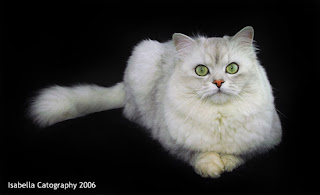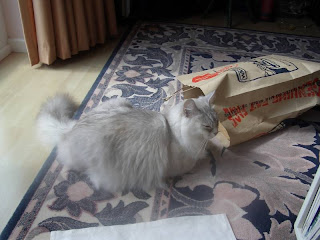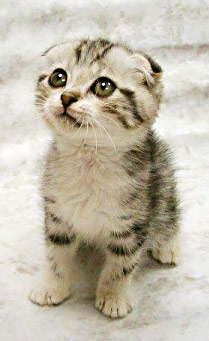
The
American Bobtail is a relatively new and uncommon
breed of
cat which has appeared since the late 1960's. It is most notable for its stubby "bobbed" tail about one-third to one-half the length of a normal
cat's tail. This is the result of a genetic mutation affecting the tail development, similar to that of a
Manx. The
cat is not related to the
Japanese Bobtail despite the similar name and physical type — the breeding programs are entirely unrelated and the gene causing the mutation is entirely different.
American bobtails are a very sturdy
breed, with both short or longhaired coats. Their coat is shaggy rather than dense or fluffy. They can have any colour of eyes and fur, with a strong emphasis on the "wild" tabby appearance in show animals.
According to legend, bobtails are the result of a crossbreeding between a domestic tabby
cat and a
bobcat. Yodie, a short-tailed brown tabby male, mated with a seal point
Siamese (
cat) female to create the
Bobtail's original bloodline. Then
Birman,
Himalayan (
cat) and
Himalayan/Siamese cross elements were added to the bloodline. Most of the early bloodlines have been eliminated. Although this is genetically possible, the
bobcat/domestic cat hybrids, particularly the male, would probably become sterile. The unusual tail is actually the result of a random spontaneous genetic mutation within the domestic
cat population or is related to the dominant Manx gene.
This
cat's original appearance genetics were modified in the
breed to form a new and improved
breed which comes in all colors, categories and divisions. New shorthair versions have appeared where once only longhair versions were fully recognized. These new lines, which invoke a gentler sweeter
cat with the remaining wild look features, may have begun in Florida It is still permitted to outcross the
Bobtail with domestic stock, so long as the currently small gene pool is kept healthy.
Manx and
Japanese Bobtails are not used in the integrated matix.
The breed was recognised by the International
Cat Association in 1989.
Development and Conformation AppearanceDevelopment–
Bobtails require two to three years to develop, slower than many domestic
cat breeds.
General– An ideally naturally occurring hearty short-tailed
cat.
Body–Moderately long and substantial; semi-cobby; stocky; noticeable rectangular stance; boning substantial; chest full and broad; hips substantial, almost as wide as chest; hind legs longer than fore legs with large round feet which may have toe tufts.
Head–Broad wedge without flat planes; size proportionate to body; concave curve from nose to brow, or rise to prominent brow; broad unpinched muzzle; non-prominent whisker pads; gently sloped wide nose; full strong jaws.
Ears–Medium-sized, wide-based; equally mounted on top and side of head; with rounded tips.
Eyes–oval to large almond shape; size proportionate to head; aperture angled to base of ear; medium wide spacing, deep sockets; color varies with coat color.
Tail–End of the tail visible above the back, but not beyond the Hock, while the animal is in repose; straight, (or curved), slightly knotted or have bumps.
Coat:
- Shorthair– length medium to short; texture resilient; all-weather; double coat with undercoat.
- Longhair– length semi-long, tapering to longer on ruff, britches, belly and tail; texture shaggy, non-matting, somewhat resilient; double coat with semi-dense undercoat of seasonal variation.
HealthDisquality ones with bad hips and Rumpies (tail-less
Bobtails with a shortened spine). These are generally not acceptable due to increased health problems.
You can see more American Bobtail cats on
gallery.
 The Asian Semi-Longhair is a cat breed similar to the Asian Shorthair except they have semi-long hair instead of short hair. These cats are also known by the name Tiffanie. They are recognised in any of the Asian Shorthair or Burmese colors and patterns. Like the Asian Shorthair, the breed was developed in Britain, and is not currently recognised by any U.S. Registries.
The Asian Semi-Longhair is a cat breed similar to the Asian Shorthair except they have semi-long hair instead of short hair. These cats are also known by the name Tiffanie. They are recognised in any of the Asian Shorthair or Burmese colors and patterns. Like the Asian Shorthair, the breed was developed in Britain, and is not currently recognised by any U.S. Registries.








































